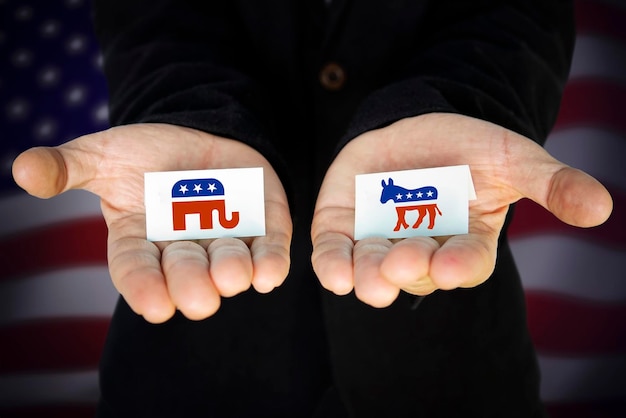How Third-Party Candidates Could Reshape the 2025 Elections

Third-party candidates in the 2025 elections could significantly impact the outcome by influencing voter turnout, shifting focus to specific issues, and potentially acting as spoilers, thereby altering the dynamics between the major parties.
The upcoming 2025 elections are already shaping up to be a pivotal moment in American politics, and understanding how **third-party candidates could impact the 2025 elections** is crucial. These candidates, often overlooked, can play a significant role in shaping the political landscape.
Understanding the Role of Third-Party Candidates
Third-party candidates are those who run for office under a banner other than the two major parties: Republican and Democrat. Their presence can introduce new ideas or highlight neglected issues, potentially reshaping the election narrative.
Historical Impact
Throughout U.S. history, third-party candidates have had notable impacts. From Theodore Roosevelt’s Progressive Party in 1912 to Ross Perot’s Reform Party in 1992, these candidates have influenced policy debates and altered election results.
Motivations and Goals
Third-party candidates often run to bring attention to specific issues they believe the major parties are ignoring. They may also seek to offer voters an alternative ideological perspective.
- Highlighting Specific Issues: Often focus on niche but vital issues.
- Providing Alternative Ideologies: Offer voters a different political philosophy.
- Challenging the Status Quo: Disrupt conventional political wisdom.
In conclusion, third-party candidates serve as potential catalysts for change, introducing unique perspectives and challenging the established norms of the political landscape.
Potential Impact on Voter Turnout in 2025
One significant way third-party candidates affect elections is by influencing voter turnout. Their presence on the ballot can energize specific segments of the electorate, drawing in voters who feel unrepresented by the mainstream parties.

Increased Engagement
Third-party candidates can excite voters who are disillusioned with the two-party system. This excitement can translate into higher voter turnout, as these individuals feel they finally have a candidate who represents their views.
Drawing in Independents
Independent voters, who often swing elections, may be more likely to participate when a third-party candidate aligns with their beliefs. This can significantly alter the outcome, especially in closely contested races.
- Energizing Disenfranchised Voters: Motivating those typically left out.
- Appealing to Independent Voters: Attracting a crucial swing vote bloc.
- Creating Enthusiasm: Fostering increased civic participation.
In summary, third-party candidates can act as a rallying point for marginalized voters, boosting overall turnout and potentially shifting the balance of power.
Shifting Focus to Specific Issues
Third-party candidates often champion specific issues that the major parties might overlook or downplay. By bringing these issues to the forefront, they can force the main candidates to address them, effectively shaping the campaign narrative.
Issue Advocacy
Whether it’s environmental concerns, economic justice, or healthcare reform, third-party candidates can use their platform to advocate for specific policies and bring these topics into the mainstream debate.
Influencing Party Platforms
When a third-party candidate gains traction on a particular issue, the major parties may adopt similar positions to attract voters. This can lead to meaningful policy changes, regardless of whether the third-party candidate wins the election.
- Elevating Overlooked Issues: Bringing niche topics into the mainstream.
- Forcing Major Parties to Respond: Influencing the platforms of larger parties.
- Shaping Public Discourse: Driving conversations on key policy matters.
In conclusion, third-party candidates can act as catalysts for policy discussions, ensuring that important but often ignored issues receive the attention they deserve.
The Spoiler Effect: How Third Parties Can Alter Outcomes
One of the most discussed effects of third-party candidates is their potential to act as spoilers. This occurs when they draw enough votes away from one of the major candidates to swing the election to the other.

Historical Examples
The 2000 presidential election is often cited as a prime example of the spoiler effect. Ralph Nader’s Green Party candidacy is believed by some to have drawn crucial votes away from Al Gore, ultimately leading to George W. Bush’s victory.
Strategic Implications
Understanding the spoiler effect can influence voter behavior and campaign strategies. Voters may strategically support a major party candidate to prevent a less desirable outcome, while campaigns may try to co-opt third-party platforms to minimize their impact.
- Drawing Votes from Major Candidates: Diverting support and altering results.
- Influencing Voter Behavior: Prompting strategic voting to avoid undesirable outcomes.
- Impacting Campaign Strategies: Forcing adjustments to counteract third-party appeal.
In summary, the spoiler effect is a critical aspect of understanding how third-party candidates can indirectly determine election results.
Challenges Faced by Third-Party Candidates
Despite their potential impact, third-party candidates face numerous challenges that hinder their ability to compete with the major parties. These challenges include funding, media coverage, and ballot access laws.
Financial Disadvantages
Major parties have significant financial advantages, allowing them to run extensive ad campaigns and build strong grassroots organizations. Third-party candidates often struggle to raise the necessary funds to compete effectively.
Media Coverage
Mainstream media tends to focus on the major party candidates, giving third-party candidates limited exposure. This lack of coverage makes it difficult for them to reach a wider audience and gain traction.
Ballot Access Laws
Many states have strict ballot access laws that make it difficult for third-party candidates to get their names on the ballot. Navigating these legal hurdles requires significant time and resources.
Third-party movements face considerable obstacles, from financial disadvantages to limited media exposure, highlighting the systemic challenges in achieving broader recognition and electoral success.
Strategies for Third-Party Success in 2025
Despite the challenges, there are strategies that third-party candidates can employ to increase their chances of success in the 2025 elections. These include targeted messaging, grassroots organizing, and strategic alliances.
Targeted Messaging
Focusing on specific issues that resonate with particular voter groups can help third-party candidates gain support. Tailoring their message to address the needs and concerns of these groups can increase their appeal.
Grassroots Organizing
Building a strong grassroots organization can compensate for the lack of financial resources. Volunteers and local activists can play a crucial role in spreading the word and mobilizing voters.
Strategic Alliances
Collaborating with other third-party groups or even forming alliances with factions within the major parties can amplify their voice and increase their influence.
- Focusing on Key Issues: Tailoring their message to resonate with voters.
- Building Local Support: Creating strong community-based organizations.
- Forming Coalitions: Partnering to amplify influence and reach.
In conclusion, while the path to success is challenging, strategic messaging, grassroots organization, and alliances can significantly enhance the prospects of third-party candidates in the upcoming elections.
| Key Point | Brief Description |
|---|---|
| 🗳️ Voter Turnout | Third parties can energize voters and increase overall participation. |
| 📣 Issue Focus | They bring neglected issues into mainstream political debate. |
| ⚠️ Spoiler Effect | Third parties might draw votes, indirectly impacting election outcomes. |
| 📊 Strategies for Success | Targeted messaging, grassroots and alliances can make a difference. |
Frequently Asked Questions
▼
A third-party candidate is someone who runs for political office representing a party other than the two major parties, which are typically the Democratic and Republican parties in the United States.
▼
They can influence elections by increasing voter turnout, focusing on specific issues, and potentially acting as spoilers by drawing votes away from major candidates, thus altering the final outcome.
▼
Third-party candidates often struggle with financial disadvantages, limited media coverage, and navigating strict ballot access laws, which hinder their ability to compete effectively with major parties.
▼
While it’s rare, third-party candidates can win elections, especially at the local level. Their best chances come when they focus on specific issues and build strong grassroots support within their communities.
▼
Success for third-party candidates often relies on targeted messaging, grassroots organizing, and forming strategic alliances to amplify their voice and increase their influence in the political arena.
Conclusion
Understanding **how third-party candidates could impact the 2025 elections** requires appreciating their multifaceted roles. From influencing voter turnout and shifting focus to specific issues, to acting as potential spoilers, these candidates introduce a dynamic element into the political landscape. While they face significant challenges, strategic approaches can amplify their influence, making them a notable factor in shaping election outcomes.
